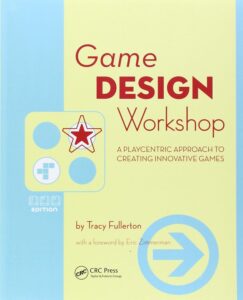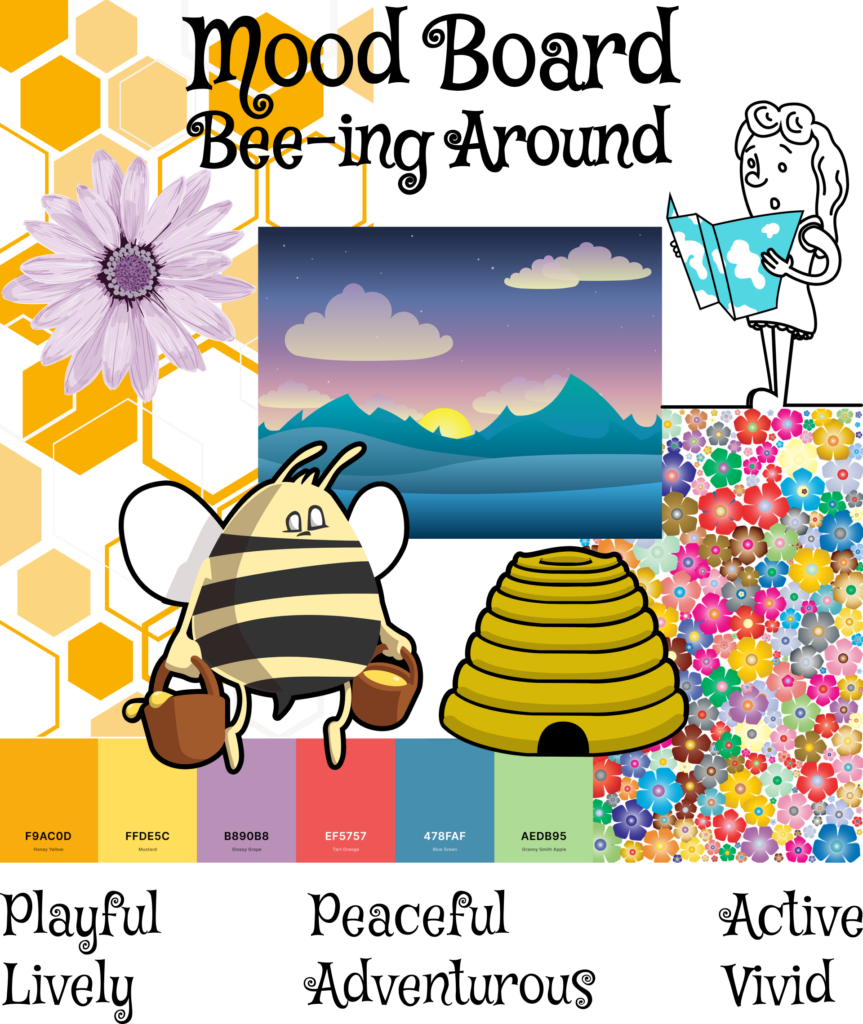BEE-ING AROUND is a single-player, location-based adventure game prototype for mobile. The player is a honey bee, who must visit flowers in order to collect their nectar and earn points all whiling avoiding hazards such as bears, cars, and forest fires. Control of the in-game player is done by physically walking around as the GPS data from the phone will track movement.
Collaborators: Karen Wang, Rifa Lalani
Problem
Bee-ing Around was part of the final coursework for ETEC 565D: Digital Games and Learning1 in the Master of Educational Technology program2 at the University of British Columbia. The goal was to collaboratively design a digital and educational game. We are allotted three months to deliver a game prototype.
As a team of three, we were composed of educators and support staff which brought diverse perspectives and reflections to the game’s design and content. None of us had prior game design experience and selecting the best game engine while learning to use it effectively was a major challenge. The project required balancing multiple components, including coding, story design, sound design, graphic art, and gameplay mechanics, while meeting the course requirements.
The purpose of the project was to create a ‘demonstrably’ educational game prototype that could be played by and presented to instructors and peers. Personally, I aimed to explore an augmented reality game utilizing location based mechanics, aligning with my interest in integrating innovative technologies into learning experiences. Location-based games I see as a gap!
This project was important not only as a course deliverable but also as an opportunity to build skills in game design, collaboration, and creative problem-solving under significant constraints.
Through my background in engineering, art, and makerspaces, I had the most experience and therefore capable of picturing the larger picture. I took on a multifaceted role that included:
- Research: Explore precedent game examples; Understand game design.
- Project management: Track development tasks and timelines; Manage tasks within the team.
- Tool Selection: Game engine; Location software development kits.
- Coding: Learning the game engine; Code and develop the game within the game engine.
- Design: Contributed to the design and development of game elements, including story, sound, and graphic design.
The key deliverables included a fully functional game prototype that demonstrated educational value, a video showcasing gameplay, and all supporting materials/documentation. Collaboration and adaptability were critical, as we had to navigate the steep learning curve of game design tools while maintaining effective communication within a newly formed team.
Action
I mapped out a development timeline to identify key milestones, top-level elements, and their dependencies. This timeline ensured we stayed on track and coordinated as a team, especially under a tight two-month deadline.
Feasibility of creating a location-based game with no experience in a tight deadline was paramount to determine.
After evaluating different game engines, I selected Unity3 as it is flexible, meets all our requirements, is an industry standard, and is able to integrate with the Mapbox SDK4 and OpenStreetMap API5 to provide location-based features.
I familiarized myself with Unity3 by learning its basics and leveraging example projects provided by Mapbox SDK4 I was ultimately able to create a viable technical prototype early in the project development.
Bee-ing Around Technical Prototype

Tracy Fullerton’s Game Design Workshop: A Playcentric Approach to Creating Innovative Games,6 proved to be an invaluable reference. A very helpful game design model are the breakdown of formal and dramatic elements.
Our process began with a project proposal,7 which detailed the structure of gameplay, design elements, and the tools we intended to use. This document provided a shared vision and reference point throughout development.
Development progressed iteratively, with frequent testing and refinement at each stage to ensure the game functioned as intended and met our educational objectives.

Results
The development of Bee-ing Around resulted in a fully functional, single-player, location-based game prototype that met the project’s goals and exceeded expectations.
In Bee-ing Around, players walk around their neighbourhoods in order to control their in-game avatar, a worker honeybee, to collect nectar, find the hive, and avoid hazards. The game is demonstrably educational, promoting environmental awareness, teaching players about bees, and providing hands-on map-reading and navigation practice. It encourages outdoor exploration, physical activity, and situated learning, fostering reflection on environmental impact through immersive gameplay and storytelling.
Bee-Dance Stop Motion Video
The game successfully integrated augmented reality concepts using the Mapbox SDK4 and OpenStreetMap API5, creating a dynamic, location-based experience. The balance between educational and playful elements ensured a fun, engaging experience suitable for all ages.
Learnings
This project enhanced my skills in game design, coding, and project management, reinforcing the importance of iterative design, play testing, and user feedback. It also offered a valuable exploration of how experiential learning and technology can be integrated into educational design. From this project, three distinct takeaways stood out:
- Everything is Figureoutable
When I started this project, I had never used a game engine before, yet I went on to develop an ambitious location-based mobile game. There were countless moments when I nearly quit and considered switching to a simpler project due to the complexity and time constraints. However, by persevering, I overcame the technical hurdles—learning the logic behind game design, the workflow of Unity, and what a SDK is as well as how to use one. - Project Management
I took ownership of this project and this perspective allowed me to be an effective team player and leader. Normally, people strive for equity in effort within team projects and my shift away from this allowed me to unreservedly apply and immerse myself into this project. I took on an outsized role in this project and grew enormously from the experience. - Player-Centric Design
Switching between the roles and respective perspectives of a player, educator, and a designer was critical to ensuring the game was both engaging and accessible. There were many design decisions where an adequate balance between what is most fun and engaging for a player, was weighed with what is demonstrably educational, and what is technologically feasible within our experience and time constraints. A multi-perspective approach contributed to our success and further time could have allowed for the incorporation of further perspectives through user research and testing.
Bee-ing Around was a personal proving ground for game-based learning, experience design, technological integration, and creative problem-solving. The experience has laid a strong foundation for future interactive projects that merge play, education, and emerging technology.

Bee-ing Around Screenshot
Footnotes
- Digital Games and Learning course created by Dr. Jen Jenson and Dr. Suzanne de Castell. https://blogs.ubc.ca/565d/
- Master of Educational Technology. University of British Columbia. https://met.ubc.ca/
- Unity is a cross-platform game engine. https://unity.com/
- The Mapbox Maps SDK for Android is a library for embedding highly customized maps within Android applications. https://docs.mapbox.com/android/maps/guides/
- OpenStreetMap is a map of the world, created by people like you and free to use under an open license. https://www.openstreetmap.org/
- Fullerton, T. (2018). Game Design Workshop: A Playcentric Approach to Creating Innovative Games (4th ed.). A K Peters/CRC Press. ISBN: 978-1138098770. https://www.gamedesignworkshop.com/
- Bee-ing Around Project Proposal. https://bee-ing-around.weebly.com/project-proposal.html